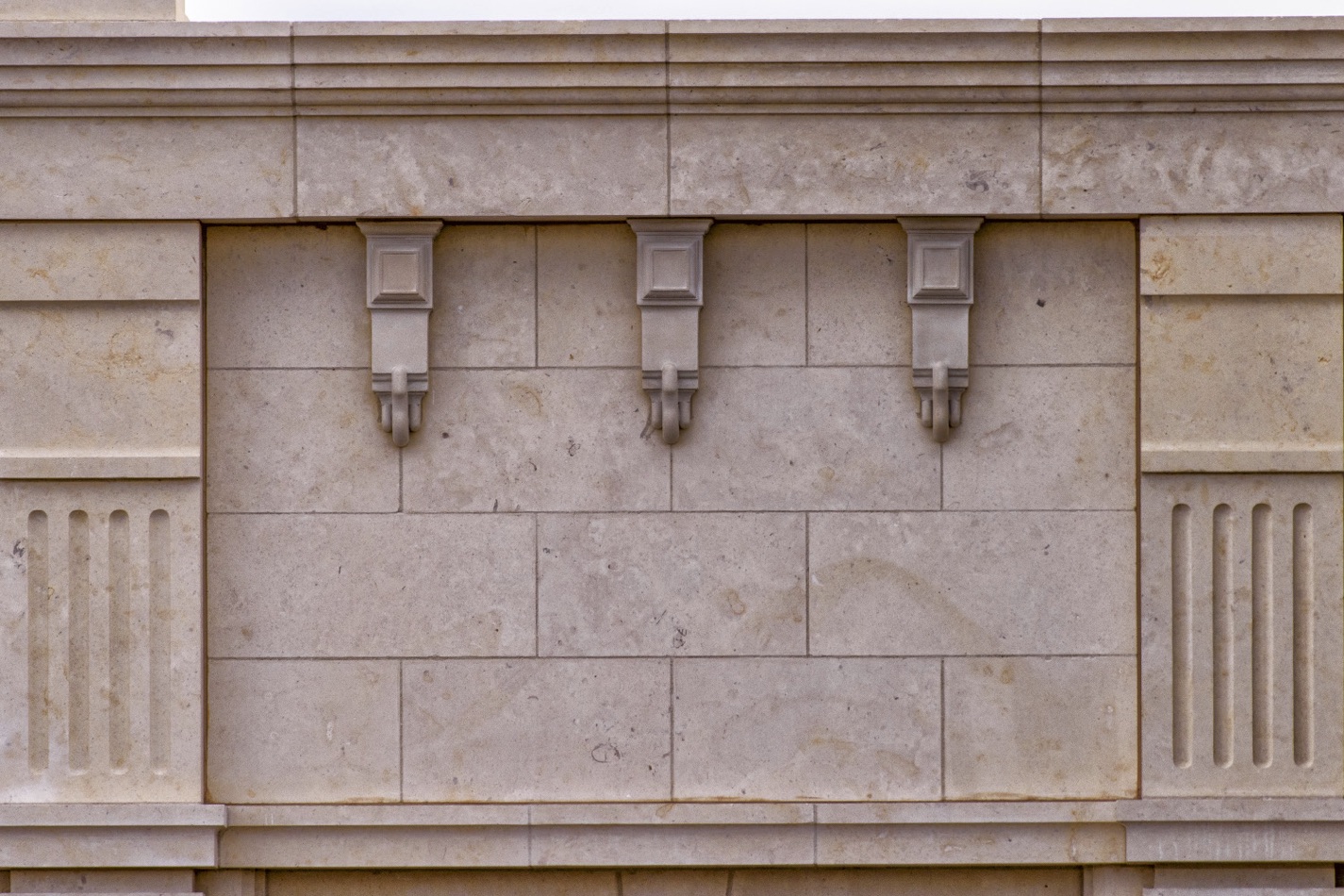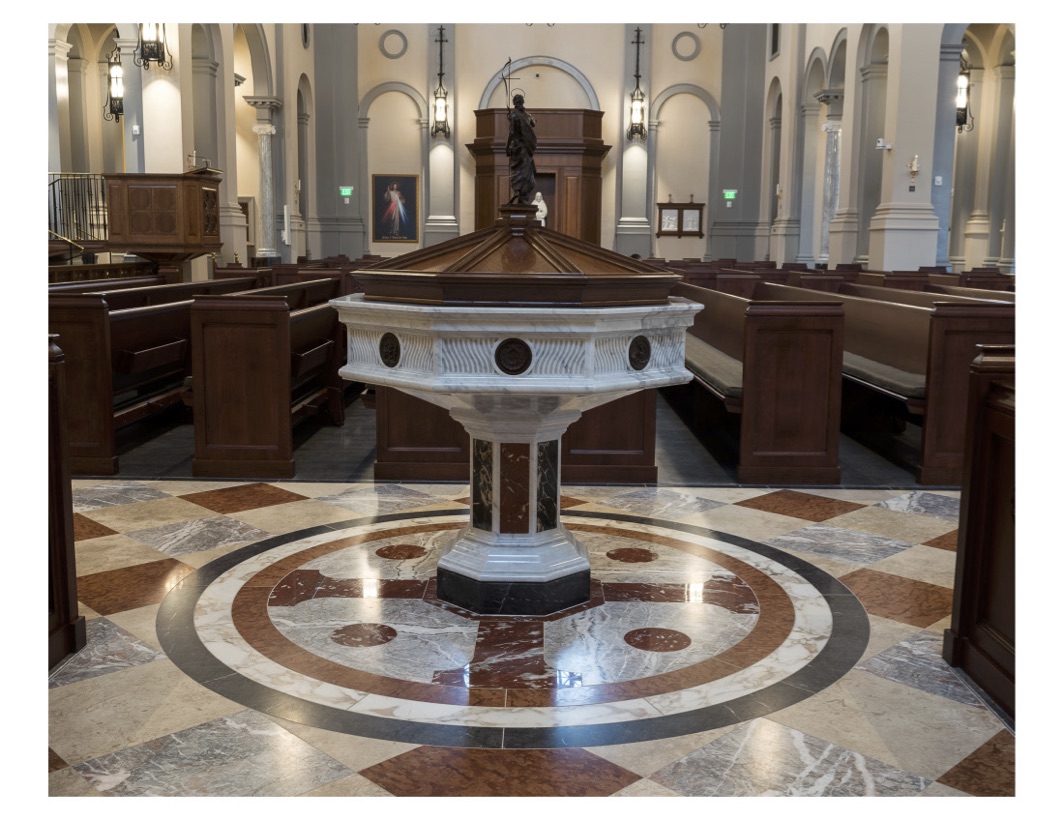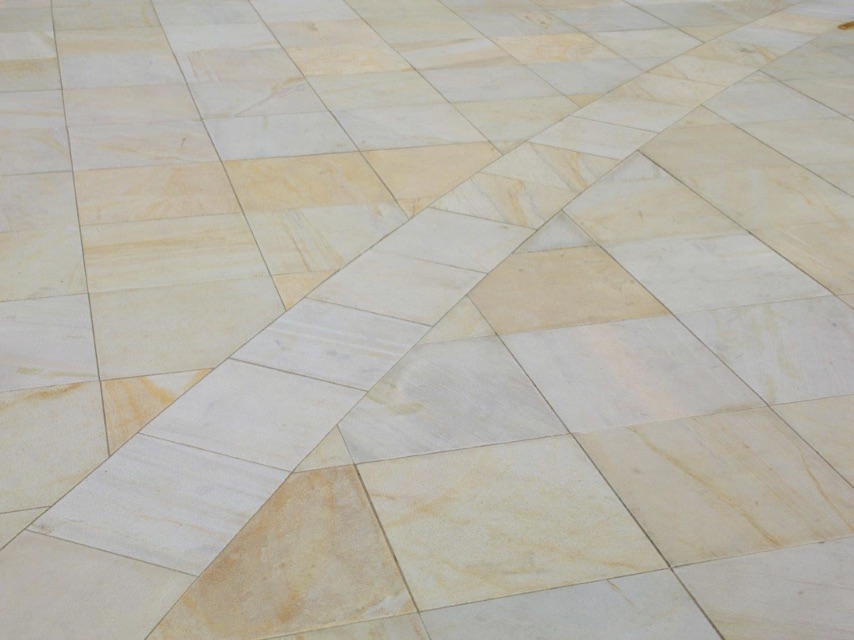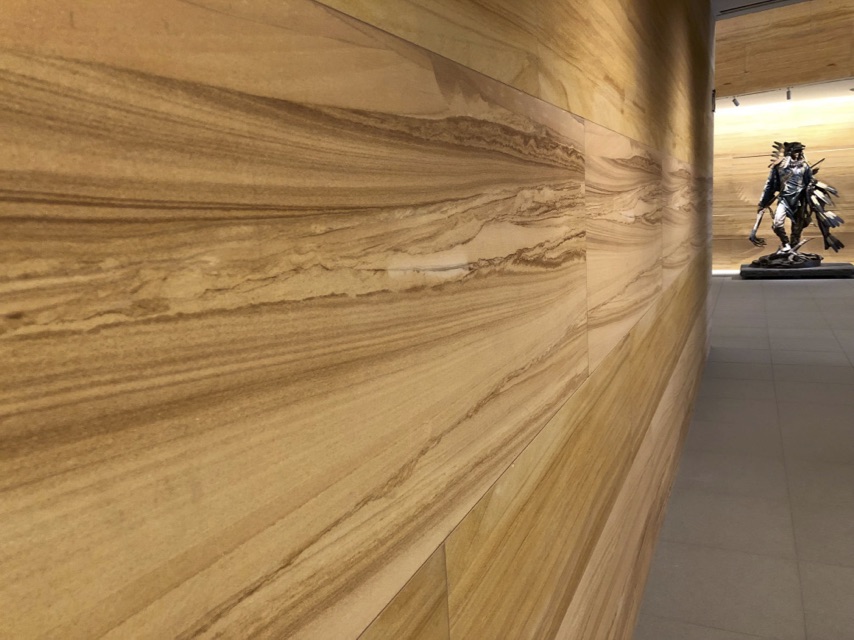
When is it appropriate to use natural stone on a project? Many of you are familiar with the TCNA Handbook for Ceramic, Glass and Stone Tile Installation that offers many methods, standards and approved installation methods for both tile and stone.
There are other standards and specifications that A&D professionals as well as tile and stone contractors would do well to consult when clients are considering stone for a job. Following are excerpts from the “Standards and Specifications for Stone Products” document, originally published in the Dimension Stone Design Manual, Version VIII (May 2016), produced and published by the Natural Stone Institute, in
Oberlin, Ohio.
The document begins by listing all the standards organizations, which will be abbreviated here with phone and URL in the interest of space.
It then explains the importance of these standards and how and when they apply, as well as an exploration of the function of the organization and the standards that it provides. It ends with a listing of ASTM standards and specifications that are essential references for specific materials, tests and other factors that affect stone
specification.
For detailed information on stone, including additional documents on selecting, working with, and installing natural stone, visit the Natural Stone Institute, www.naturalstoneinstitute.org.
1.0 ORGANIZATIONS
1.1 ASTM International
Telephone: 610.832.9585
European Office:
Telephone: 146.243.7933
1.2 American National Standards Institute (ANSI)
Telephone: 212.642.4900
1.3 NSF International
Telephone: 734.769.8010
European Office:
Telephone: 32.2.771.36.54
1.4 European Commission for Standardization (CEN)
Telephone: 32.2.550.08.11


2.0 WHY ASTM STANDARDS AND OTHER LIKE STANDARDS ARE IMPORTANT
2.1 In today’s building environment, the emphasis is on safe, permanent, low maintenance products, of which stone leads the list in the minds of architects, designers, and consumers worldwide.
2.2 Without a consistent, realistic set of standards and testing procedures for stone products, the stone industry as a whole would be in disarray. The standards that have been developed and set in place for these products are important tools to help protect end users, individual companies, and the industry from negative effects related to product failures. Materials standards help to prevent the use of stone products for unsuitable applications. For instance, without the minimum standards for Abrasion Resistance of Stone Subjected to Foot Traffic (ASTM C241), it would be more likely that very soft, easily damaged materials would be installed in commercial applications. This may cause the owner to incur additional cost for repair and maintenance, and negatively affect the reputation of the stone industry as a whole.
2.3 These standards also serve as benchmarks for quality limits of products. If a stone with a below-minimum flexural strength is used for a lintel, then it may be more likely to fail, thus causing damage and possible injury. Interior or exterior flooring or paving with an inadequate slip resistance level will more likely cause slipping accidents in public or private projects.
3.0 HOW AND WHEN THESE STANDARDS APPLY
3.1 As stone industry professionals, it is our task to apply the correct standards to materials at appropriate times in order to keep the stone industry strong and to remain a reliable source of quality products.
3.2 Most architectural specifications require that stone meet certain specified ASTM or other testing standards before it will be accepted for use. Some products on the market today have not been tested for quality standards that are required for certain projects. The required testing should be reviewed and, if test results are not available for the stone product, then testing should be performed by the quarry or representative company as required. Some quarries and their representatives do not embrace this idea because their products can be marketed to homeowners and residential projects without the need to perform testing. It is up to our industry to know how to identify these products and make sure to request the required material data needed.
3.3 Testing of stone can be performed by other companies in the event that required test data are not available. Independent labs can perform the appropriate tests and provide the information in a well organized, professional report.
3.4 It is important to know when a certain test is not required for a product. For example, a test for Slip Resistance would not be necessary for stone used in a vertical application, which will never receive foot traffic. Some examples are not as easily established. For instance, what are the needs for testing a stone to be used for interior flooring in a commercial application where the stone is installed over a raised floor deck subject to deflection, and will be subject to traffic from pedestrians and cleaning carts weighing 1,000 pounds? It may be required that the stone of choice meets standards related to Slip Resistance, Abrasion Resistance, Absorption, Compressive Strength, and Bending Strength. These are all physical requirements of the stone product during everyday use.
3.5 Be aware of the requirements of performance that will be placed on the stone at the time of installation, and in the future. If a stone has proven not to perform for a particular use, then avoid marketing it for that use. If testing is not available, require that it be done or avoid the product’s use.
4.0 ASTM INTERNATIONAL
4.1 The American Society for Testing and Materials International (ASTM), founded in 1898, is a not-for-profit organization that provides a global forum for the development and publication of voluntary consensus standards for materials, products, systems, and services. Over 30,000 individuals from 100 nations are the members of ASTM International, who are producers, users, consumers, and general interest parties such as government representatives and academicians.
4.2 Committees are established that focus on and have jurisdiction over standards for different designations, such as Dimension Stone (Committee C18) or Cement (Committee C01). These committees are made up of several subcommittees which are tasked to develop and discuss individual segments within the committee’s jurisdiction. For example, one subcommittee may deal with the development of standards dealing with Test Methods of Dimension Stone, and another with Anchorage Components and Systems for Natural Stone. These committees meet on a regular basis to discuss and present information for each new or existing standard.
4.3 The entire membership of ASTM International votes on whether a standard is suitably developed and researched before it is forwarded for final approval. Negative votes cast during the balloting process are fully resolved before forwarding.
4.4 Companies, agencies, and individuals use ASTM standards. Buyers and sellers of materials, products, and services include these standards in contracts; engineers, scientists, architects, and designers use them in their work; government agencies reference them in codes and regulations; and many others refer to them for performance information.
4.5 ASTM International is recognized globally and continues to review and develop new standards needed in a wide range of materials.


5.0 ANSI
5.1 The American National Standards Institute (ANSI), founded in 1918 by five engineering societies and three government agencies, is a private, not-for-profit organization that administers and coordinates U.S. voluntary standards and conformity assessment activities. The Institute represents the interests of its nearly 1,000 company, organization, government agency, institutional, and international members through its office in New York City and its headquarters in Washington, D.C.
5.2 ANSI currently provides a forum for over 270 ANSI-accredited standards developers representing approximately 200 distinct organizations in the private and public sectors. These groups work cooperatively to develop voluntary national consensus standards and American National Standards (ANS).
5.3 The ANSI standardization process provides and promotes standards that withstand scrutiny, yet protect the rights and interests of all participants. This process helps quicken the market acceptance of products, while advising how to improve the safety of those products to protect consumers.
5.4 U.S. standards are promoted internationally by ANSI. The organization also advocates U.S. policy and technical positions in international and regional standards organizations, as well as supporting the acceptance of international standards as U.S. standards where they meet the needs of the user community.
5.5 The Institute is active internationally with the International Organization for Standardization (ISO), and, via the U.S. National Committee (USNC), the International Electrotechnical Commission (IEC). In many instances, U.S. standards are taken forward to ISO and IEC through ANSI or the USNC, where they are adopted in whole or in part as international standards.
6.0 NSF INTERNATIONAL
6.1 NSF International, formerly the National Sanitation Foundation, is a not-for-profit, non-governmental organization that provides standards, certification, education, and risk management services in the fields of public health safety and the environment. NSF was founded in 1944 in response to a need for a single set of food equipment sanitation standards that manufacturers and operators could accept and regulators could adopt into code. NSF has 21 standards for all types of products and materials used in food service. The standards contain requirements for materials, design, construction, and performance of food service equipment to ensure that it is safe and can be kept sanitary. Today, NSF Food Equipment Standards are globally recognized, and certification to the standards is required by regulators, specified by end users, and marketed by manufacturers.
6.2 NSF Material Requirements – Standard 51. An important component of the NSF Food Equipment Standards is the material requirements. While each standard can have its own unique material requirements, all food equipment standards reference NSF/ANSI Standard 51-2002, Food Equipment Materials. The material requirements help to ensure that only nontoxic and cleanable materials are used. Material suppliers have utilized NSF Certification to Standard 51 as an effective method for marketing their products to food equipment manufacturers. Manufacturers who purchase NSF-certified materials have one less item of concern when getting their own equipment certified.
6.3 Applying Standard 51 to Natural Stone. When reviewing granite, marble, and other natural stones to the requirements of Standard 51, there are essentially two issues that can determine its acceptance: smoothness and toxicity.
6.4 Smoothness. The standard defines “smooth” as free of surface imperfections that are detectable by visual or tactile inspection. This includes pits, cracks, and crevices. This concern for smooth surfaces applies not only to the natural surface, but also the treatments used to make a surface smooth. Application of a coating is sometimes considered a way of addressing smoothness; however, coatings have a tendency to chip or flake over time, thus creating their own difficult-to-clean surface. As a result, there is a prohibition on the use of coatings for surfaces subjected to cutting and chopping actions, such as countertops and cutting boards. It is important to note that this prohibition would not necessarily apply to all surface treatments the natural stone industry might use. Sealers that are buffed off to the point where they only remain to fill surface imperfections are not considered a “coating” for the purposes of NSF standards, and could potentially be used on countertops and cutting boards.
6.5 Toxicity. Standard 51 requires that materials meet FDA regulations for their intended end use, as specified in the Code of Federal Regulations, Title 21 (21 CFR). Applying Standard 51 toxicity requirements to the stone is fairly easy. Because natural stone does not fall under the scope of 21 CFR, we simply conduct extraction testing to verify that the material does not contain any regulated heavy metals. When sealers are used, NSF must have verification from the sealant manufacturer that it meets 21 CFR. An alternative is that the sealant manufacturer can obtain an NSF certification.
Copies of each standard can be obtained online or by fax from the source.


7.0 ASTM SPECIFICATIONS AND STANDARDS
7.1 Material Specifications
7.1.1 ASTM C503, Standard Specification for Marble Dimension Stone (Exterior)
7.1.2 ASTM C568, Standard Specification for Limestone Dimension Stone
7.1.3 ASTM C615, Standard Specification for Granite Dimension Stone
7.1.4 ASTM C616, Standard Specification for Quartz-Based Dimension Stone
7.1.5 ASTM C629, Standard Specification for Slate Dimension Stone
7.1.6 ASTM C1526, Standard Specification for Serpentine Dimension Stone
7.1.7 ASTM C1527, Standard Specification for Travertine Dimension Stone
7.2 Test Standards
7.2.1 ASTM C97, Standard Test Method for Absorption and Bulk Specific Gravity of Dimension Stone
7.2.2 ASTM C99, Standard Test Method for Modulus of Rupture of Dimension Stone
7.2.3 ASTM C120, Standard Test Method of Flexure Testing of Slate (Modulus of Rupture, Modulus of Elasticity)
7.2.4 ASTM C121, Standard Test Method for Water Absorption of Slate
7.2.5 ASTM C170, Standard Test Method for Compressive Strength of Dimension Stone
7.2.6 ASTM C217, Standard Test Method for Weather Resistance of Slate
7.2.7 ASTM C241, Standard Test Method for Abrasion Resistance of Stone Subjected to Foot Traffic
7.2.8 ASTM C880, Standard Test Method for Flexural Strength of Dimension Stone
7.2.9 ASTM C1201, Standard Test Method for Structural Performance of Exterior Dimension Stone Cladding Systems by Uniform Static Air Pressure Difference
7.2.10 ASTM C1352, Standard Test Method for Flexural Modulus of Elasticity of Dimension Stone
7.2.11 ASTM C1353, Standard Test Method for Abrasion Resistance of Dimension Stone Subjected to Foot Traffic Using a Rotary Platform Abraser
7.2.12 ASTM C1354, Standard Test Method for Strength of Individual Stone Anchorages in Dimension Stone
7.3 Other Application Standards
7.3.1 ASTM Manual Series: MNL 21. Modern Stone Cladding: Design and Installation of Exterior Dimension Stone Systems. 1995.
7.3.2 ASTM A666, Standard Specification for Annealed or Cold-Worked Austenitic Stainless Steel Sheet, Strip, Plate, and Flat Bar
7.3.3 ASTM B221, Standard Specification for Aluminum and Aluminum-Alloy Extruded Bars, Rods, Wire, Profiles, and Tubes
7.3.4 ASTM C36/C36M, Standard Specification for Gypsum Wallboard
7.3.5 ASTM C91, Standard Specification for Masonry Cement
7.3.6 ASTM C119, Standard Terminology Relating to Dimension Stone
7.3.7 ASTM C144, Standard Specification for Aggregate for Masonry Mortar
7.3.8 ASTM C150, Standard Specification for Portland Cement
7.3.9 ASTM C207, Standard Specification for Hydrated Lime for Masonry Purposes
7.3.10 ASTM C270, Standard Specification for Mortar for Unit Masonry
7.3.11 ASTM C482, Standard Test Method for Bond Strength of Ceramic Tile to Portland Cement Paste
7.3.12 ASTM C630/C630M, Standard Specification for Water-Resistant Gypsum Backer Board
7.3.13 ASTM C920, Standard Specification for Elastomeric Joint Sealants
7.3.14 ASTM C1242, Standard Guide for Selection, Design, and Installation of Exterior Dimension Stone Anchors and Anchoring Systems
7.3.15 ASTM C1515, Standard Guide for Cleaning of Exterior Dimension Stone, Vertical and Horizontal Surfaces, New or Existing
7.3.16 ASTM C1528, Standard Guide for Selection of Dimension Stone for Exterior Use
7.3.17 ASTM C1721, Standard Guide for Petrographic Examination of Dimension Stone
7.3.18 ASTM C1722, Standard Guide for Repair and Restoration of Dimension Stone
7.3.19 ASTM E72, Standard Test Methods of Conducting Strength Test of Panels for Building Construction
7.3.20 ASTM E119, Standard Test Methods for Fire Test for Building Construction
7.3.21 ASTM E575, Standard Practice for Reporting Data from Structural Tests of Building Constructions, Elements, Connections, and Assemblies
7.4 ANSI Specifications and Standards
7.4.1 ANSI A10.20, Safety Requirements for Ceramic Tile, Terrazzo and Marble Work
7.4.2 ANSI A108, Standards for Installation of Ceramic Tile
7.4.3 ANSI A118, Specifications for Mortars and Grouts
7.5 NSF/ANSI Specifications and Standards
7.5.1 NSF/ANSI Standard 51, Food Equipment Materials
7.6 CEN Specifications and Standards
7.6.1 CEN specifications and standards are in the process of being compiled. This information will be available at a later date.
All standards and specifications are revised or updated periodically. The current status of any standard or specification can be confirmed by contacting the proper authority.









